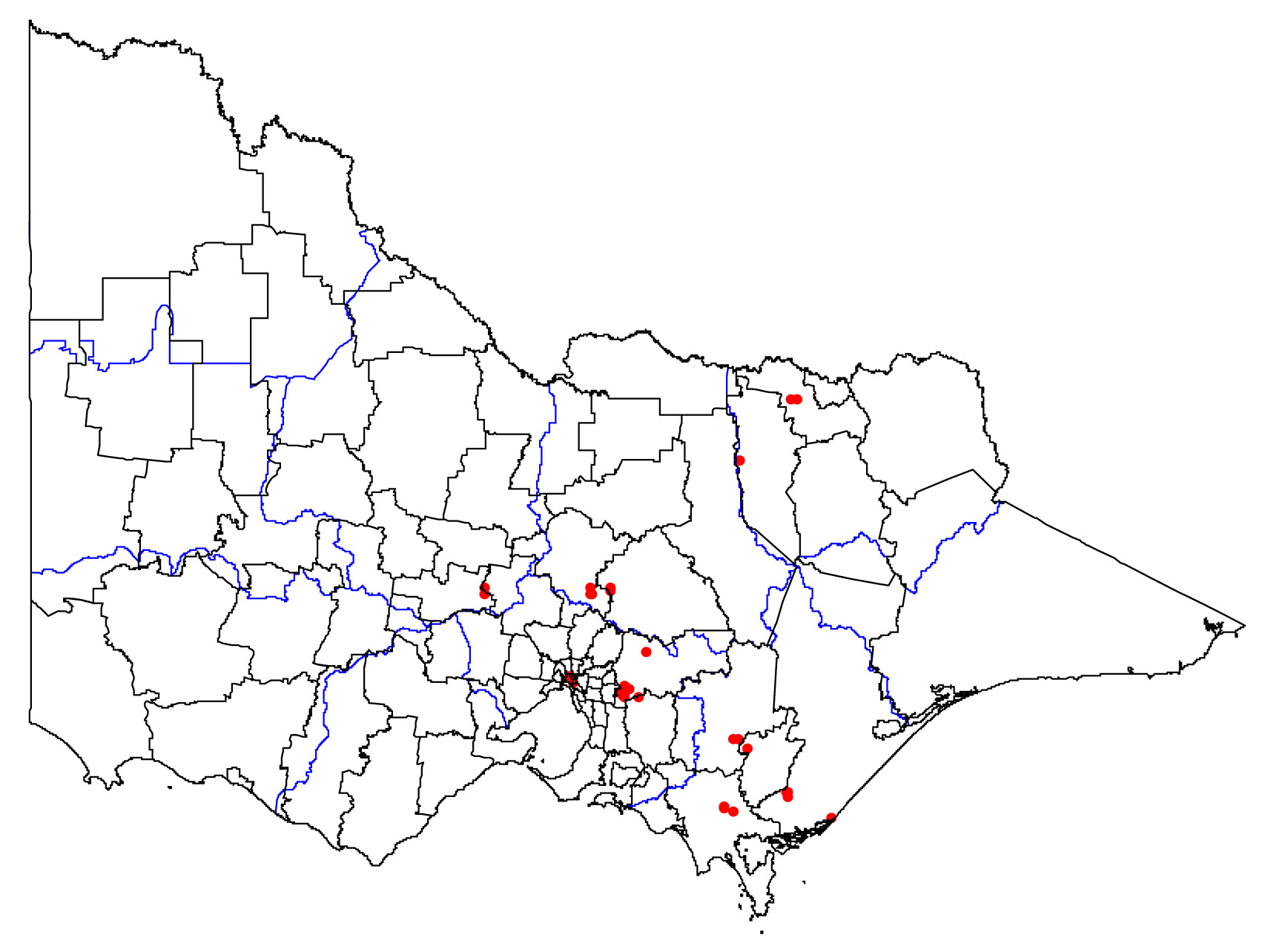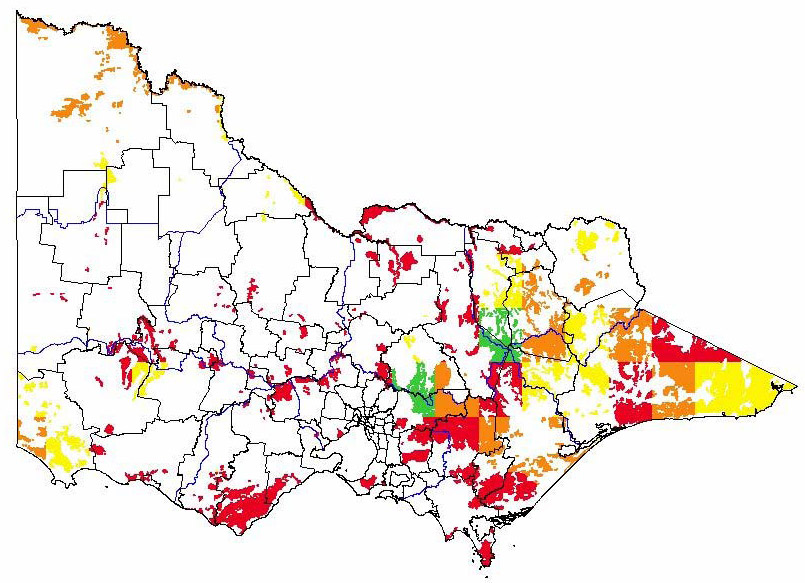Red cestrum (Cestrum elegans)
Present distribution
|  Map showing the present distribution of this weed. | ||||
| Habitat: Evergreen shrubs and trees native to the tropical areas in the Americas (particularly Mexico). It grows best in riparian forests (Muyt, 2001), but is fairly drought tolerant (Dave’s Garden website). ALL PLANT PARTS ARE POISONOUS IF INGESTED (O’Hara). | |||||
Potential distribution
Potential distribution produced from CLIMATE modelling refined by applying suitable landuse and vegetation type overlays with CMA boundaries
| Map Overlays Used Land Use: Forestry and horticulture. Broad vegetation types Lowland forest; inland slopes woodland; sedge-rich woodland; moist foothills forest; montane moist forest; sub-alpine woodland; valley grassy forest; herb-rich woodland; sub-alpine grassy woodland; montane grassy woodland; riverine grassy woodland; riparian forest; rainshadow woodland; mallee woodland; wimmera /mallee woodland Colours indicate possibility of Cestrum elegans infesting these areas. In the non-coloured areas the plant is unlikely to establish as the climate, soil or landuse is not presently suitable. | 
|
Impact
QUESTION | COMMENTS | RATING | CONFIDENCE |
| Social | |||
| 1. Restrict human access? | Little or no effects expected in literature reviewed. However, as it forms dense thickets (Muyt, 2001) it may be extrapolated that it may cause restrictions. | ML | M |
| 2. Reduce tourism? | Little or no effects expected in literature reviewed. However, as it forms dense thickets that exclude all other vegetation (Muyt, 2001) it may be extrapolated that it may reduce tourism through reduced access to preferable sites/regions/flora. | ML | M |
| 3. Injurious to people? | All parts of this plant are highly toxic (O’Hara, undated) if ingested (Dave’s garden website) Some people develop skin rash from handling plant parts (Muyt, 2001) | H | MH |
| 4. Damage to cultural sites? | Little or no effects expected in literature reviewed. However, as it forms dense thickets that exclude all other vegetation (Muyt, 2001) it may be extrapolated that it may cause adverse effects to cultural sites. | ML | M |
| Abiotic | |||
| 5. Impact flow? | Terrestrial species; therefore little or no effects expected. | L | L |
| 6. Impact water quality? | Terrestrial species; therefore little or no effects expected. | L | L |
| 7. Increase soil erosion? | Terrestrial species; therefore little or no effects expected. | L | L |
| 8. Reduce biomass? | Little or no effects expected in literature reviewed. However, as it forms dense (Muyt, 2001) it may be extrapolated that it may cause effects. | L | M |
| 9. Change fire regime? | Little or no effects expected in literature reviewed. However, as it forms dense (Muyt, 2001) it may be extrapolated that it may cause adverse effects by a build up of fire fuel. Fire combustibility was unmentioned in literature reviewed. | ML | M |
| Community Habitat | |||
| 10. Impact on composition (a) high value EVC | EVC = Sedgy Riparian Woodland (V); CMA = Corangamite; Bioreg = Otway Ranges; VH CLIMATE potential. It grows best in riparian forests (Muyt, ’01). Fast growth that forms dense thickets that exclude all other vegetation (Ibid.) May form monoculture within a specific layer; displace all spp. within a strata/layer. | H | MH |
| (b) medium value EVC | EVC = Lowland Forest (D); CMA = Corangamite; Bioreg = Otway Ranges; VH CLIMATE potential. It grows best in riparian forests (Muyt, ’01). Fairly drought tolerant (Dave’s Garden website) Fast growth that forms dense thickets that exclude all other vegetation (Ibid.) May form monoculture within a specific layer; displace all spp. within a strata/layer. | H | MH |
| (c) low value EVC | EVC = Riparian Forest (LC); CMA = Corangamite; Bioreg = Otway Ranges; VH CLIMATE potential. It grows best in riparian forests (Muyt, ’01). Fairly drought tolerant (Dave’s Garden website) Fast growth that forms dense thickets that exclude all other vegetation (Ibid.) May form monoculture within a specific layer; displace all spp. within a strata/layer. | H | MH |
| 11. Impact on structure? | Form monoculture/dense thickets that exclude all other vegetation (Muyt, 2001). | H | MH |
| 12. Effect on threatened flora? | Form dense thickets that exclude all other vegetation (Muyt, 2001). | ML | MH |
| Fauna | |||
| 13. Effect on threatened fauna? | All parts of this plant are highly toxic (Muyt, 2001, O’Hara, undated) if ingested (Dave’s garden website) | ML | MH |
| 14. Effect on non-threatened fauna? | All parts of this plant are highly toxic (Muyt, 2001, O’Hara, undated) if ingested (Dave’s garden website) Attracts butterflies (Top Tropicals website) | ML | MH |
| 15. Benefits fauna? | Little or no effects expected in literature reviewed. | M | L |
| 16. Injurious to fauna? | All parts of this plant are highly toxic (Muyt, 2001, O’Hara, undated) if ingested (Dave’s garden website) | H | MH |
| Pest Animal | |||
| 17. Food source to pests? | All parts of this plant are highly toxic (O’Hara, undated) if ingested (Dave’s garden website). But, berries produced to attract mobile eaters. | ML | L |
| 18. Provides harbour? | Form dense thickets (Muyt, 2001). | ML | L |
| Agriculture | |||
| 19. Impact yield? | Not a known weed of agriculture, therefore little or no effects expected in literature reviewed. | L | L |
| 20. Impact quality? | Not a known weed of agriculture, therefore little or no effects expected in literature reviewed. | L | L |
| 21. Affect land value? | Not a known weed of agriculture, therefore little or no effects expected in literature reviewed. | L | L |
| 22. Change land use? | Not a known weed of agriculture, therefore little or no effects expected in literature reviewed. | L | L |
| 23. Increase harvest costs? | Not a known weed of agriculture, therefore little or no effects expected in literature reviewed. | L | L |
| 24. Disease host/vector? | Not a known host/vector, therefore little or no effects expected in literature reviewed. | L | L |
Invasive
QUESTION | COMMENTS | RATING | CONFIDENCE |
| Establishment | |||
| 1. Germination requirements? | Requires natural seasonal disturbances, such as seasonal rainfall, spring/summer temperatures for germination. | MH | L |
| 2. Establishment requirements? | This plant likes well-drained and fertile soils (coolexotics website) sun and semi shade and regular water (calfloranursery website). Plant is able to establish under a moderate canopy. | MH | MH |
| 3. How much disturbance is required? | Invades damp scherophyll forests and riparian vegetation (Carr et al, 1992). It can invade disturbed riparian environments and cool moist forests in Victoria and NSW (Muyt, 2001) and also invade undisturbed bush (Stewart-Howie, 2003). The plant has the ability to colonise in both relatively intact and minimally disturbed ecosystems. | MH | MH |
| Growth/Competitive | |||
| 4. Life form? | Family: Solanaceae Perennial (Dave’s Garden website) Shrubs to 2.4 – 3 m (Muyt, 2001, Dave’s Garden website) 5-8ft (O’Hara.) Night-flowering (sunnygardens website) Life form is that of a shrub. | L | MH |
| 5. Allelopathic properties? | None mentioned in literature reviewed. | L | L |
| 6. Tolerates herb pressure? | None mentioned in literature reviewed. | M | L |
| 7. Normal growth rate? | Fast growth, tough and vigorous (Dave’s Garden website) Form dense thickets that exclude all other vegetation (Muyt, 2001). Rapid growth rate that will exceed most other species of the same life form. | H | MH |
| 8. Stress tolerance to frost, drought, w/logg, sal. etc? | Fairly drought tolerant, not over watering or waterlogging (Dave’s Garden website) Plants damaged by heavy frosts usually ‘come back’ quickly (sunnygardens website). Susceptible to at least two stresses. | L | L |
| Reproduction | |||
| 9. Reproductive system | Vigorous suckering (Muyt, 2001). Sexual. | H | MH |
| 10. Number of propagules produced? | Not mentioned in literature reviewed, nor the number of flowers in inflorescences. Number of propagules estimated at 500 – 1,500 per annum. | M | L |
| 11. Propagule longevity? | Seeds can remain viable for at least eight years (Muyt, 2001). Greater than 25% of seeds survive 5 - 10 years in the soil. | ML | MH |
| 12. Reproductive period? | Not mentioned in literature reviewed however it has been noted that the plant out competes all native ground cover plants in this environment and threatens to form a total monoculture (Stewart-Howie, 2003). Mature plant produces viable propagules for 3 – 10 years. | MH | L |
| 13. Time to reproductive maturity? | Flowered six weeks after planting (Dave’s Garden website). Reaches maturity and produces viable propagules in under a year. | H | ML |
| Dispersal | |||
| 14. Number of mechanisms? | Produces red berries (Richardson, et al. 2006) to attract mobile berry eaters. Flowers attract hummingbirds (sunnygardens website; calfloranursery website). Edible fruit that is readily eaten by highly mobile animals. | H | MH |
| 15. How far do they disperse? | Not mentioned in literature reviewed. | M | L |
References
Dave’s Garden website. (2000-2006) http://davesgarden.com/pf/go/2741/index.html [Accessed 06 Dec., ’06.]
Muyt, A. (2001) Bush Invaders of South-East Australia. RG and FJ Richardson, Meredith, Victoria. ISBN: 0 958 7438 7 5. pg. 162.
O’Hara, S.A. (undated) Cestrum – Mediterranean climate gardening throughout the world. The Mediterranean Garden Society webpage
http://www.mediterraneangardensociety.org/plants/Cestrum.cfm [Accessed 06 Dec., ’06.]
Richardson, FJ, Richardson, RG, and Shepherd, RCH. (2006) Weeds of the South-East. An Identification Guide for Australia. RG and FJ Richardson, Meredith, Victoria. pg. 386.
SunnyGardens website. (1999-2006) http://www.sunnygardens.com/garden_plants/cestrum/cestrum_0613.php [Accessed 06 Dec., ’06.]
Top Tropicals website. (undated) http://toptropicals.com/catalog/uid/CESTRUM_ELEGANS.htm [Accessed 06 Dec., ’06.]
United States Department of Agriculture website. http://plants.usda.gov/java/profile?symbol=CEEL4 [Accessed 06 Dec., ’06.]
Feedback
Do you have additional information about this plant that will improve the quality of the assessment?
If so, we would value your contribution. Click on the link to go to the feedback form.


